In Part 2, Joe told us about his experiences during the D-day landings. Now we can read about life in Normandy and north west Europe as the 21st British Army Group took on the Germans lodged in the low-lying areas of land around the Scheldt River estuary during the winter of 1944.
Joe Ingham’s story:
Normandy
For weeks now we were engaged in small operations, being called in to reduce stubborn opposition from pockets of German troops dug in in concrete gun or machine gun emplacements. Of course the AVRE is not a fighting tank. It is exactly what it’s name suggests; an armoured vehicle. It was invaluable as a shield to enable sappers to work under cover in situations where exposed troops would have been soon knocked out.
The battle of Lion-sur-Mer illustrated perfectly how our results were achieved. For instance, a gun emplacement in the village was very well dug in and commanded the approach to the village. The concrete pill-boxes were very well constructed. Very little protruded above ground, just enough to provide the occupants with vision and their guns to traverse the area. In spite of all the infantry’s efforts, the enemy machine gunners were still in action and our troops were pinned down by enemy fire.
Our AVRE was sent for to to help and whilst our machine gunner kept up a continuous fire, we advanced and ”parked” the AVRE on top of the mound where the enemy post was sited. Here we were safe as long as infantry’s guns prevented the Germans getting out of their pill-box.
My job was next. I climbed out of the side hatch, on the ”safe” side of the AVRE and placed a ”BEEHIVE” on top of the concrete dome. I pushed the primer into the top of the ”BEEHIVE”, fed the leads back through my side hatch and climbed back inside. We then retreated back towards our troops about 30 yards from the pill-box. I blew the BEEHIVE. There was a satisfactory bang and when the smoke had cleared, the top of the pill-box had been pushed in and there was nothing left of the enemy fire. An infantry sergeant dropped a hand grenade in for good measure, but I doubt it was necessary.
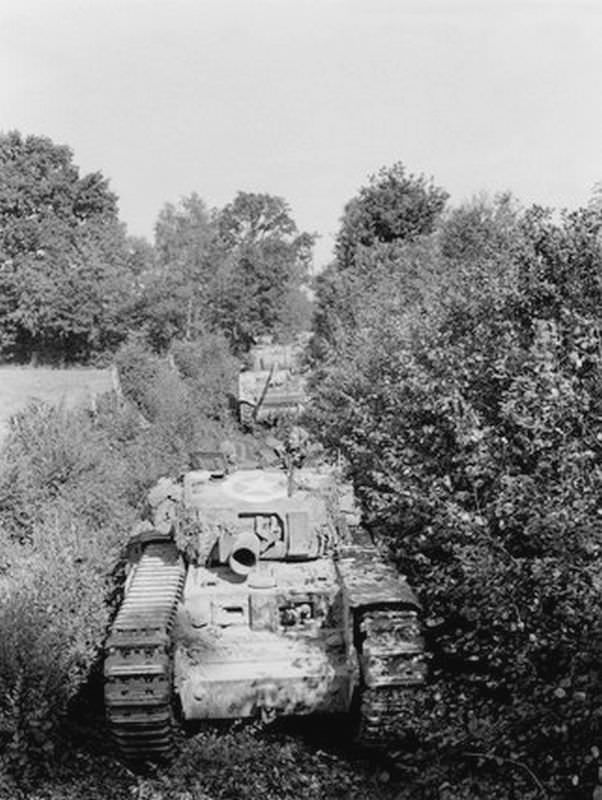
As the weeks passed by, the Squadron lost many AVRE’s and crews, but life went on. The enemy was being gradually pushed back away from the bridgehead and men and equipment were pouring into France but some enemy held areas were proving stubborn. The area around Falaise was still in German hands. What was required was a concentrated attack on a narrow front to penetrate the ring of German defences then we could turn and attack from behind.
The main problem was the minefield laid between the Germans and us. We, together with the 1st Lothians, were chosen to clear the way through. This was August 7th. We assembled in line ahead like an armoured spear, led by the CRAB’s of the 1st Lothian then the AVRE’s followed by the tanks of the Tank Regiment. The whole operation went without a hitch. The planning which went into it showed imagination and an ability to simplify problems.
We towed a steel trailer loaded with screw pickets and cycle front lamps. We started at midnight and were kept on course by a machine gunner who fired tracer bullets overhead pointing for us the way to go. Two of our crew paid out white tapes about 1/2 inch wide from each side door. L/Sgt. Phillips walked behind our AVRE on the right hand side. He pushed the screw pickets into the ground to mark the right hand side of the safe path, hung a bicycle lamp with the red glass facing backwards and twisted the tape around the picket. I walked behind the AVRE and put the blue lamps on the left hand side facing backwards. Obviously progress was slow because the FLAIL’s had to do a thorough job.
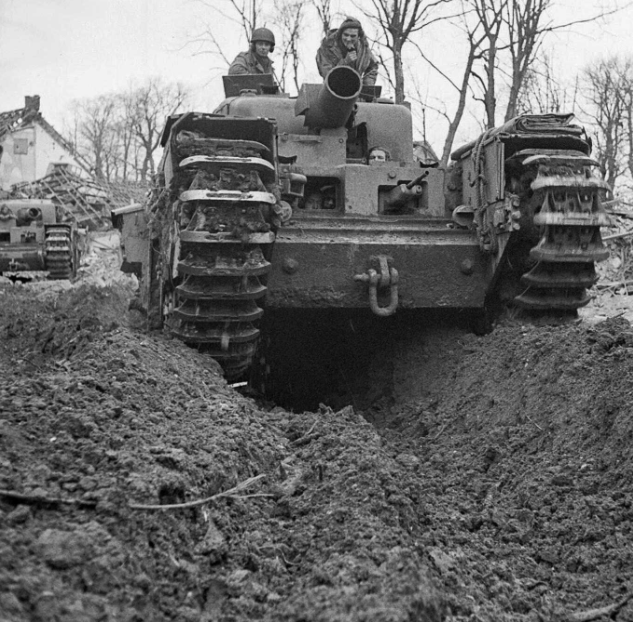
Many mines were destroyed that night and we walked a very long way. There was firing going on all the time but we hadn’t time to worry about it. By the time the paths were finished we were in the rear of the enemy and the tanks following us fanned out on either side . We, in the AVRE’s stayed-put. Personally I was glad to get back in the AVRE. Next morning our tanks attacked and were were able to drive back down our own cleared path. One of the FLAIL tanks was hit and burnt out, but that was the only one I saw”.
The Scheldt
‘During the rest of August and early September we said good bye to our AVRE’s and given a new form of transport, the TERRAPIN. This was an amphibious boat shaped truck with very large road wheels and two extra road wheels under its sloping belly at the front. It had an open top so that the crew stood on the deck and we were surrounded by a low wall which equalled the lower half of a lorries sides.
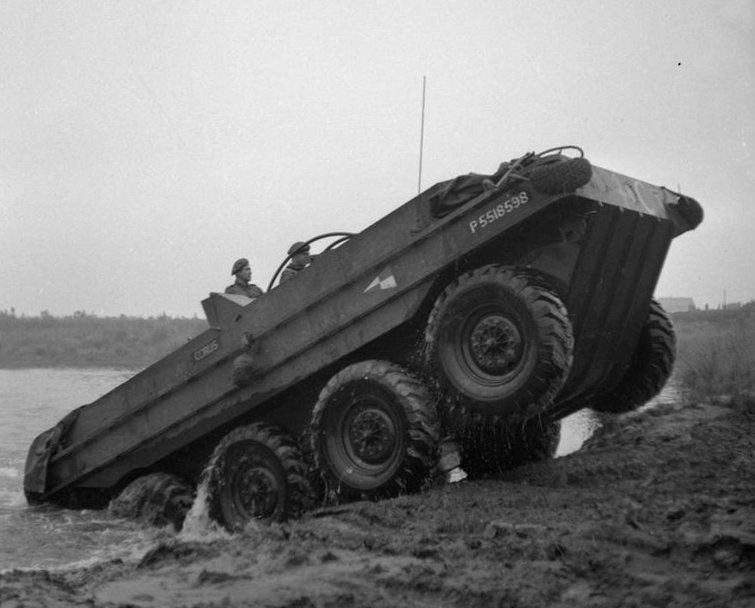
The mechanics were strange as there were two Ford V8 engines side by side each driving the wheels on its own side. To steer it unequal power was applied by accelerating one engine and decelerating the other. So to turn right, the left hand engine was speeded up, so that the left hand wheels tried to overtake the right hand ones causing the TERRAPIN to turn. In water, two propellers provided extra power, but the wheels continued to revolve, and as on land, they steered the truck. The driver held two vertical rods like joysticks, these were the accelerators,when pushed forward they revved the engine and drove the wheels. They performed well enough on land but we found it difficult to climb out of the water especially when the river was flowing fast. We were sent to Tamise in Belgium to practice, but even when wooden tracks were provided on the steep banks, exit from the water was a problem.
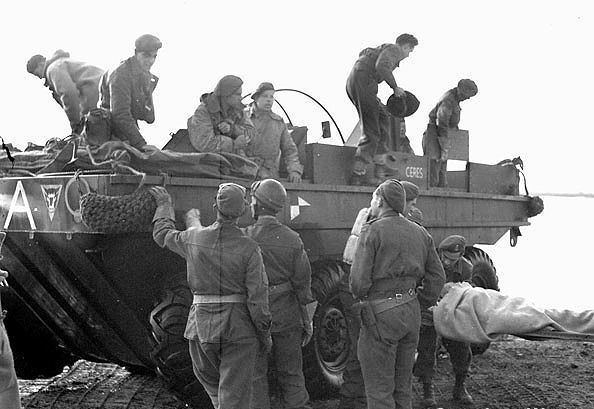
A far more successful vehicle was the one we had later on called the BUFFALO. This was basically a thin shelled open top armoured vehicle with specially designed tracks to provide propulsion in water. Instead of a normal track,as one on a land tank, it had a thin ”scoop” track, like a double letter ”C” which pushed the water backwards thus pushing the water forwards. Being of steel construction, unlike the TERRAPIN, the walls provided some protection when in the water.
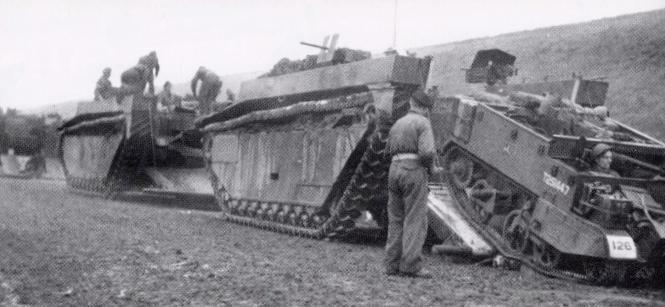
We were moved to a town called Terneuzen on the river Scheldt. The Allies needed a sea port closer than those in use, and it was vital that Antwerp should be available. Unfortunately it is inland and the river mouth is guarded by three islands; North and South Beveland and Walcheren. All were occupied by the German army and any shipping going up-stream to Antwerp would come under enemy fire.
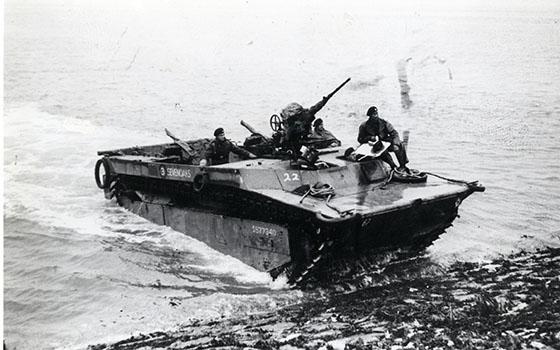
It was decided to clear these one at a time and we would transport our troops and supplies across the river. We first had to clear the banks of the river and we attacked what was later called the BRECKEN POCKET. We attacked at night, ferrying the 9th Canadian Infantry Brigade across the river under intense smoke cover put up by the R.E.’s further up the banks. Unfortunately the ramps which the 1st Canadians put down to help us land, broke up under the weight of the vehicles, and every BUFFALO had to be helped out of the river by armoured bulldozers, which delayed the action. When we attacked later on, we had a different problem.
The journey by water was much longer and when set sail from Terneuzen it was pitch dark. We sailed in a straight line, each BUFFALO keeping in the wake of the one in front, so a to present as small as a target as possible to the enemy. To help us, each BUFFALO had on its stern a group of coloured lights and each of us knew the code we had to follow. The enemy defended by firing machine guns with tracer bullets at us. It was a very peculiar experience, watching a line of bullets come skimming over the water. Every fifth bullet ‘lit up’ with a trail of sodium so there were four unlit bullets between each pair of lit ones. Fortunately, it is very difficult to hit a target which is low in the water as we were, because small waves which occur in all rivers caused the bullets to ricochet, and we saw the sodium trail deflected upwards over our heads but of course,the closer we got to the enemy, the less the ricochets occurred.
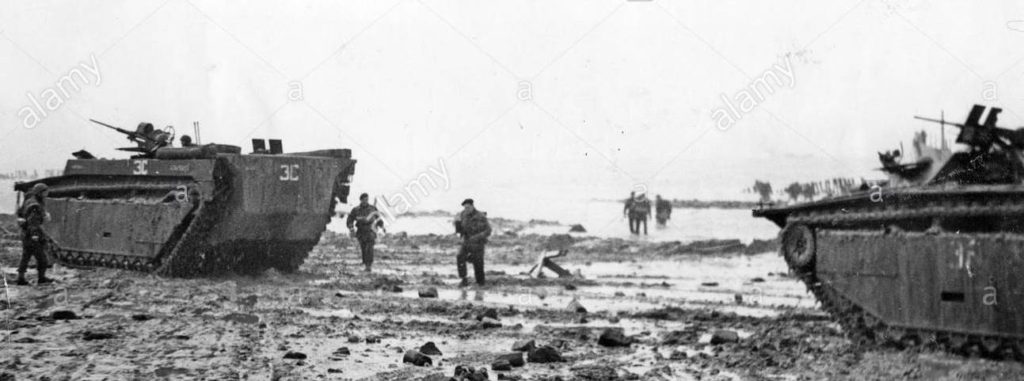
There was also one other characteristic of the Scheldt which was worrying. It is a very shallow river and has many sand banks, so every now and again our leading BUFFALO appeared to rise put of the water, followed shortly by us as we negotiated yet another patch of sand. There was nothing we could do about it. I had lost my status of demolition sapper and was commander of our BUFFALO, but all I could do was to tell the driver Sapper Wilkinson, to follow exactly our orders and keep behind the BUFFALO in front. The operation lasted, without respite, for four days and nights. Together with the rest of our squadron, we moved two infantry brigades and part of a recce regiment followed by all stores, water, petrol and ammunition. It was very cold work and we were grateful for the daily issue of Navy rum to keep out the cold. Steel decks are not the most comfortable places to sit, especially when they are wet.
Our next assault was South Beveland and the drill was the same as before. It is difficult to separate the two battles in my memory but again the R.E.’s provided us with continuous thick white smoke which rolled along the top of the water from up the river. I remember vaguely, the endless ferrying backwards and forwards across the water. I remember hearing that our Major’s BUFFALO got lost, missing the target area, finished up in pitch darkness on a sand bank and fired on from three directions-left, right and from the front. Wisely, he stopped and lay ”doggo” until first light next morning, when to his horror, he found himself at the entrance to Flushing harbour. He beat a hasty retreat and got away with it.
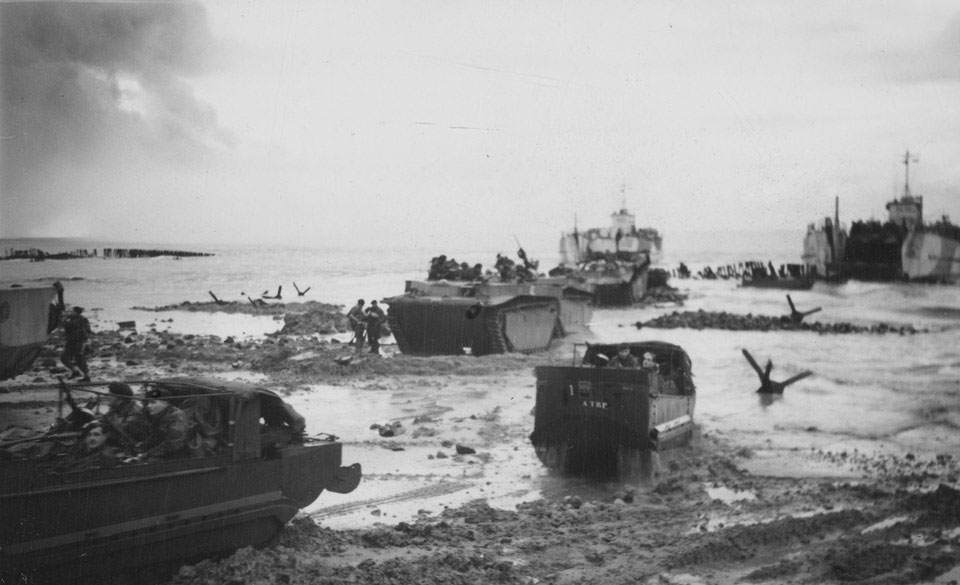
These operations proved a great deal. First, it established the BUFFALO as an invaluable tool, and improved designs were built with more protection and better fire-power. They also proved how difficult it was to attack firmly established troops in watery conditions. It wasn’t until the 8th November that the enemy surrendered. 27 BUFFALO’s were lost during the operation and the remainder were used until they were practically falling to pieces. I do not think that the designers had ever envisaged such prolonged or arduous use, quite simply the vehicles could not take the strain.
Our troops were exhausted and I was suffering fatigue to the point where I found it impossible to concentrate or plan. The Medical Officer ordered many of us back for rest and I found myself in 32 British General Hospital in Wavre, Belgium
Joe Ingham was kept in hospital for quite a while, and in fact was not allowed to return to his unit, being appointed the hospital’s newspaper editor instead. He was then transferred to the Royal Engineers personnel records in Brussels where he ran a small team logging and filing the details of all RE men in Europe. He was then sent to a Reinforcement Holding Unit in Halifax from which he was quickly discharged back into the civilian world with, apparently, little ceremony or preparation.
Joe’s demobbing would have been fairly typical - though possibly less protracted than most. Compared with those who leave the Forces today, he would have had almost zero support, and, like so many others, might have struggled to regain a sense of perspective in the years after the War.
We owe so much to the men and women of that time for doing what they did. Few are left today - so we should perhaps make an extra effort to show our appreciation for all that they endured. Ed.
The article was published with the permission of Joe’s family, and made available courtesy of Roger Brown.

Comments on AVREs, Terrapins and Buffalos: Part 3 of Joe Inghams story.